
The Fastest Birds In The World
What is the fastest bird in the world? Observing flight speed demands differentiating between sustained level flight and specialized diving maneuvers. According to the Guinness Book of World Records, the White-throated Needletail holds the title for the fastest horizontal flight, reaching an impressive 170 km/h, and the Peregrine Falcon (Falco peregrinus), known for unparalleled stoops during hunts, attains a staggering 389 km/h in a controlled dive, making it the fastest in the world by maximum airspeed. These record-setting feats highlight birds’ remarkable evolutionary adaptations for speed, including aerodynamic feathers, specialized skeletal structures, and powerful musculature.
Maximum Airspeed
The Fastest Birds In The World By Maximum Airspeed
| Rank | Common Name | Maximum Airspeed |
|---|---|---|
| 1 | Peregrine falcon | 389 km/h (242 mph) |
| 2 | Golden eagle | 322 km/h (200 mph) |
| 3 | Saker falcon | 320 km/h (200 mph) |
| 4 | Gyrfalcon | 209 km/h (130 mph) |
| 5 | White-throated needletail | 170 km/h (105 mph) |
| 6 | Eurasian hobby | 159 km/h (99 mph) |
| 7 | Frigatebird | 153 km/h (95 mph) |
| 8 | Spur-winged goose | 143 km/h (89 mph) |
| 9 | Red-breasted merganser | 130 km/h (81 mph) |
| 10 | Common swift | 111.6 km/h (69.3 mph) |
1. Peregrine Falcon

The peregrine falcon (Falco peregrinus) is widely recognized as the fastest bird, and indeed, the fastest animal, by maximum airspeed. During its iconic hunting stoop, or high-speed dive, peregrines can exceed speeds of 320 km/h (200 mph), with some estimates even higher, though reliably measured top speeds reach about 184 km/h (114 mph). This crow-sized raptor, characterized by a blue-grey back, barred underparts, and distinctive black head markings, inhabits diverse habitats from the Arctic tundra to urban skyscrapers, where feral pigeons are a key prey species. Peregrines exhibit notable sexual dimorphism, with females significantly larger than males. Historically threatened by pesticide use, particularly DDT, the species has recovered substantially due to protective measures and breeding programs. Valued in falconry for its hunting prowess, the peregrine falcon has also held cultural significance worldwide.
2. Golden Eagle

The golden eagle (Aquila chrysaetos) ranks among the fastest birds globally in terms of maximum airspeed, known for achieving impressive diving speeds when hunting prey. The golden eagle also ranks fourth worldwide by the maximum horizontal speed of around 129 km/h (80 mph.) A powerful raptor native to the Northern Hemisphere, this eagle exhibits remarkable agility and speed, diving at velocities approaching 240-320 km/h (150-200 mph). Golden eagles use this extraordinary speed, coupled with strong feet and sharp talons, to capture prey such as rabbits, hares, and marmots. Distinguished by dark brown feathers and golden-brown plumage on their nape, they possess large wingspans reaching up to 2.34 meters (7 ft 8 in), aiding their rapid and agile flight. Highly regarded in falconry and symbolic across cultures, golden eagles build nests in high locations and maintain extensive hunting territories.
3. Saker Falcon
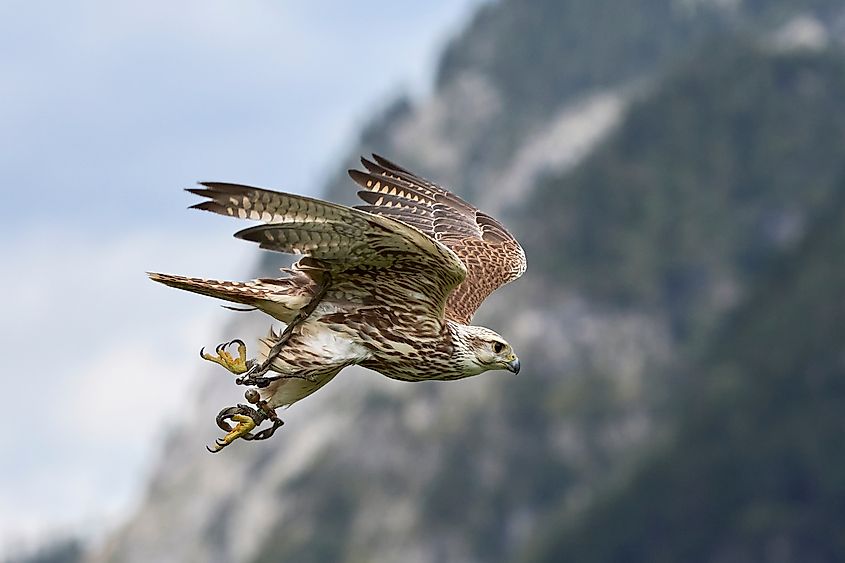
The saker falcon (Falco cherrug) is also known for remarkable airspeed during hunting dives or "stoops," reaching speeds nearing 300 km/h (190 mph). Ranked third fastest by airspeed after the peregrine falcon and golden eagle, the saker falcon can also sustain impressive horizontal flight speeds up to 150 km/h (93 mph), second only to the white-throated needletail. Native to a broad region from Central Europe across Asia, sakers exhibit partial migration, wintering in regions such as Africa's Sahel and the Qinghai-Tibet Plateau. Renowned historically for falconry, especially in the Arabian Peninsula, this falcon holds significant cultural symbolism and is the national bird of several countries, including Hungary, Mongolia, and multiple Arab states. Physically, it measures 45-57 cm in length with a wingspan of up to 126 cm, resembling a large, robust gyrfalcon characterized by varied brown plumage and sharp calls.
4. Gyrfalcon
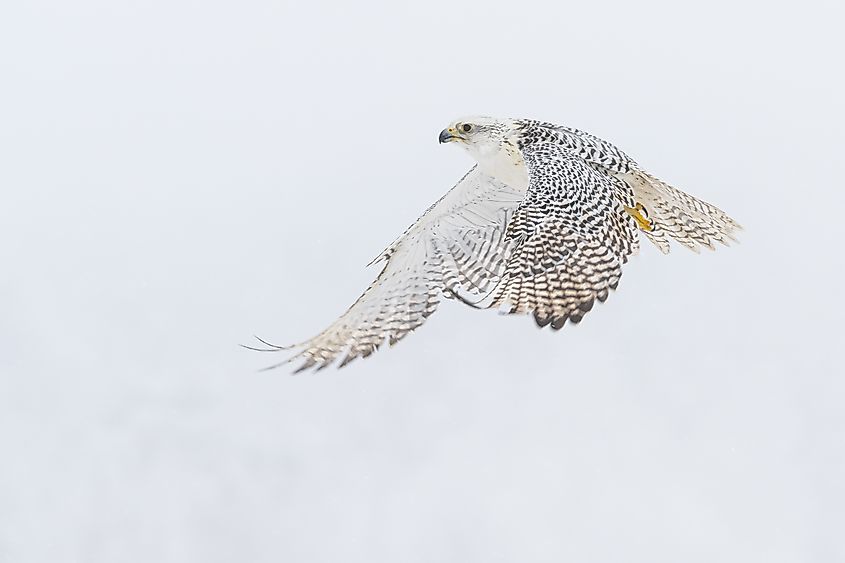
The gyrfalcon (Falco rusticolus) is the largest falcon species in the world; it inhabits Arctic coasts, tundra regions, and islands across northern North America and the Eurosiberian region. Its remarkable hunting agility allows it to swiftly pursue prey such as ptarmigan and waterfowl mid-flight, reaching dive speeds approaching 209 km/h (130 mph). The gyrfalcon also ranks as the third fastest bird in the world by horizontal speed, with a maximum horizontal speed of 145 km/h (90 mph.) Plumage varies widely, from pure white to dark brown or black morphs, adapted to blend into its diverse Arctic habitats. Historically prized in falconry due to its hunting prowess and powerful build, the gyrfalcon has long been regarded as a symbol of prestige.
5. White-Throated Needletail

The white-throated needletail (Hirundapus caudacutus), also known as the needle-tailed swift, is among the fastest birds by maximum airspeed, and the fastest by maximum horizontal speed, reputedly capable of reaching speeds up to 170 km/h (105 mph) in horizontal flight. A migratory bird, it breeds in Central Asia and southern Siberia, wintering across the Indian subcontinent, Southeast Asia, and Australia. Rarely seen in Western Europe, occasional sightings occur in Scandinavia and Great Britain. Needletails spend most of their life airborne, feeding primarily on flying insects such as beetles, flies, and moths. Measuring approximately 20 cm and weighing 110-120 grams, the species has a robust, barrel-like body, characterized by greyish-brown plumage, a distinctive white throat, and a white patch extending from the tail base to the flanks. Its name derives from its uniquely spined tail feathers, distinguishing it from other swift species.
6. Eurasian Hobby
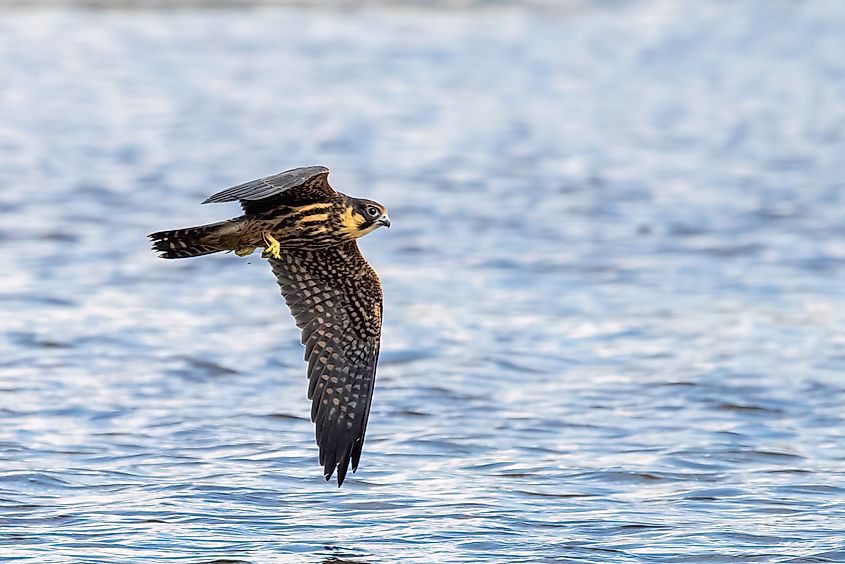
The Eurasian hobby (Falco subbuteo) is a small, agile falcon renowned for its exceptional speed and aerial skill. With a maximum airspeed approaching 159 km/h (99 mph), the hobby captures prey in swift, precise maneuvers, often catching swallows, martins, dragonflies, and even bats mid-flight. It has a slender, streamlined form, measuring approximately 29-36 cm (11-14 inches) in length, with a wingspan of 74-84 cm (29-33 inches). Adults feature slate-grey upperparts, dark crowns, black facial stripes, and rufous thighs, while juveniles display browner, scaled plumage. Migratory populations breed throughout Europe and Asia and winter in Africa and southern Asia, whereas Southeast Asian populations are mostly resident. Preferring open habitats with scattered trees, the Eurasian hobby nests in abandoned crow nests. Historically prized in falconry for its boldness and speed, this species remains admired for its remarkable aerial agility.
7. Frigatebird

Frigatebirds (family Fregatidae, genus Fregata) rank among the fastest seabirds by maximum airspeed, capable of swift, agile flight, reaching speeds over 153 km/h (95 mph). With distinctive black plumage, deeply forked tails, and wingspans up to 2.3 meters, they have the highest wing-area-to-body-weight ratio among birds, enabling remarkable aerial endurance. Spending most daylight hours aloft, frigatebirds soar effortlessly on wind currents, hunting fish and squid forced to the ocean's surface by larger predators. They are also kleptoparasitic, often stealing prey from other seabirds mid-flight. Found throughout tropical and subtropical oceans, frigatebirds exhibit notable sexual dimorphism: males inflate striking red throat pouches during mating displays. Nesting colonially, they breed biennially, producing one egg per season with prolonged parental care.
8. Spur-Winged Goose
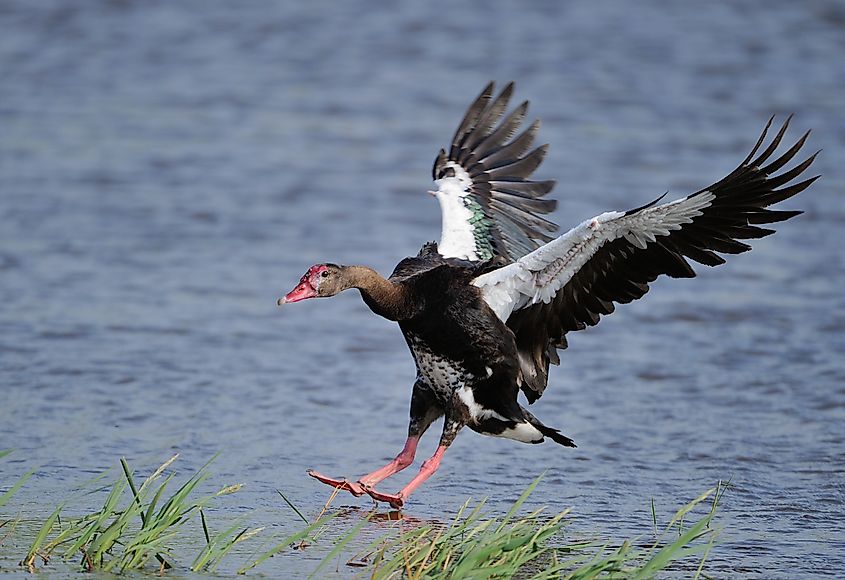
The spur-winged goose (Plectropterus gambensis) reaches speeds of approximately 143 km/h (89 mph). Native to wetlands across sub-Saharan Africa, this goose is distinctive for its large size, measuring 75-115 cm (30-45 inches) long and weighing between 4-10 kg (8.8-22 lbs), making it among the heaviest African waterfowl. Identified by black plumage, prominent white facial and wing patches, and pinkish-red legs, the species exhibits notable sexual dimorphism, with males significantly larger and displaying prominent facial markings. Unlike typical geese, it shows aggressive territorial behavior, notably utilizing sharp wing spurs in confrontations. Interestingly, some populations can become toxic due to dietary consumption of blister beetles containing the poison cantharidin, posing dangers to humans.
9. Red-Breasted Merganser
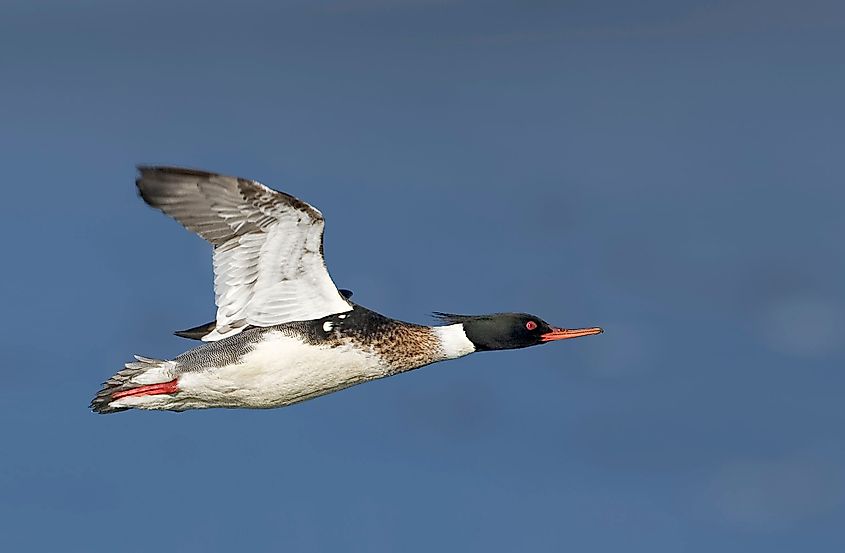
The red-breasted merganser (Mergus serrator) famously holds the record as the fastest duck, with a maximum airspeed of 130 km/h (81 mph.) Native across much of the Northern Hemisphere, this duck is notable for its distinctive appearance: males display a dark green head, white neck, rusty-red breast, and a spiky crest, whereas females have rusty heads and gray bodies. Equipped with a specialized serrated bill, the species expertly hunts slippery fish underwater. Unique among mergansers, it migrates between freshwater breeding habitats in northern lakes and rivers and coastal saltwater wintering areas, forming flocks that can number up to 100 individuals. While classified as a species of least concern globally, local threats include habitat destruction, pollution, and incidental capture in fishing gear, highlighting the importance of conservation efforts to protect its habitats and populations.
10. Common Swift
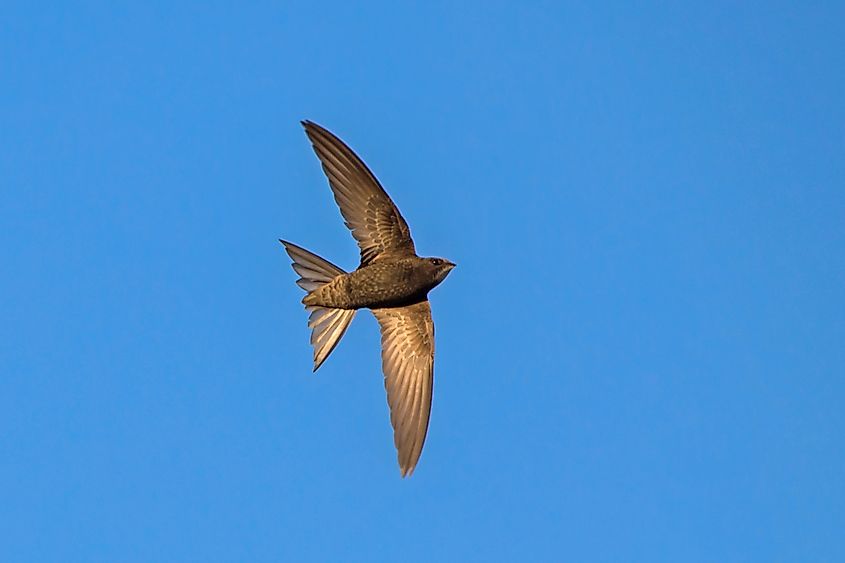
The common swift (Apus apus) is capable of reaching speeds exceeding 111 km/h (69 mph) in flight. Often confused with swallows due to their similar appearance, common swifts belong to the order Apodiformes and are related to hummingbirds and treeswifts. They possess short legs, ideal for clinging vertically, and rarely land on the ground. Known for extraordinary aerial endurance, non-breeding swifts can spend up to ten consecutive months airborne. Measuring 16-17 cm (6.3-6.7 in) in length, with a wingspan of 38-40 cm (15-16 in), their distinctive swept-back wings and forked tail enable agile, high-speed flight. Swifts form vocal "screaming parties," flying together near nesting sites or high in the air, likely facilitating social interaction and navigation.
Maximum Horizontal Speed
The Fastest Birds In The World By Maximum Horizontal Speed
| Rank | Common name | Maximum Horizontal Speed |
|---|---|---|
| 1 | White-throated needletail | 170 km/h (105 mph) |
| 2 | Saker falcon | 150 km/h (93 mph) |
| 3 | Gyrfalcon | 145 km/h (90 mph) |
| 4 | Golden eagle | 129 km/h (80 mph) |
| 5 | Grey-headed albatross | 127 km/h (79 mph) |
| 6 | Common swift | 111.6 km/h (69.3 mph) |
| 7 | Peregrine falcon | 110 km/h (68 mph) |
| 8 | Anna's hummingbird | 96.5 km/h (60 mph) |
1. White-Throated Needletail
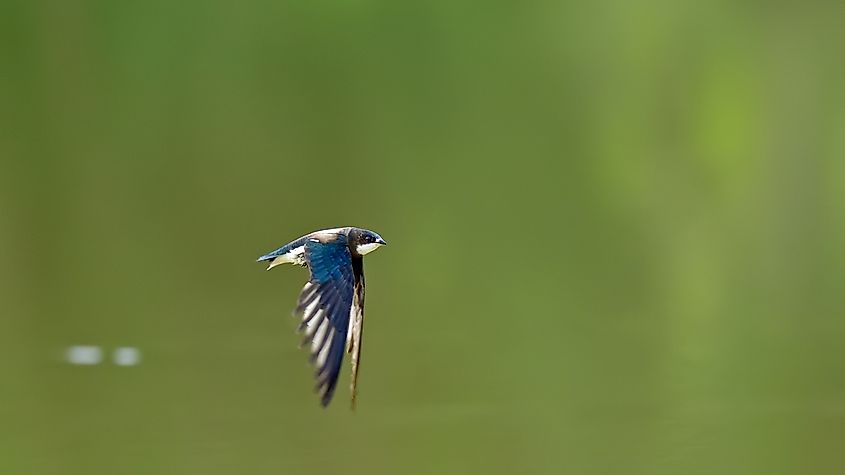
2. Saker Falcon
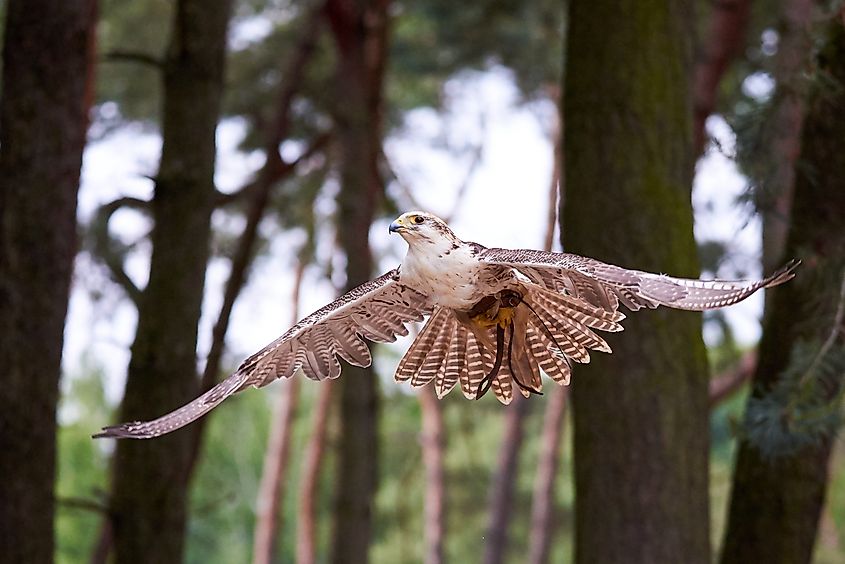
3. Gyrfalcon
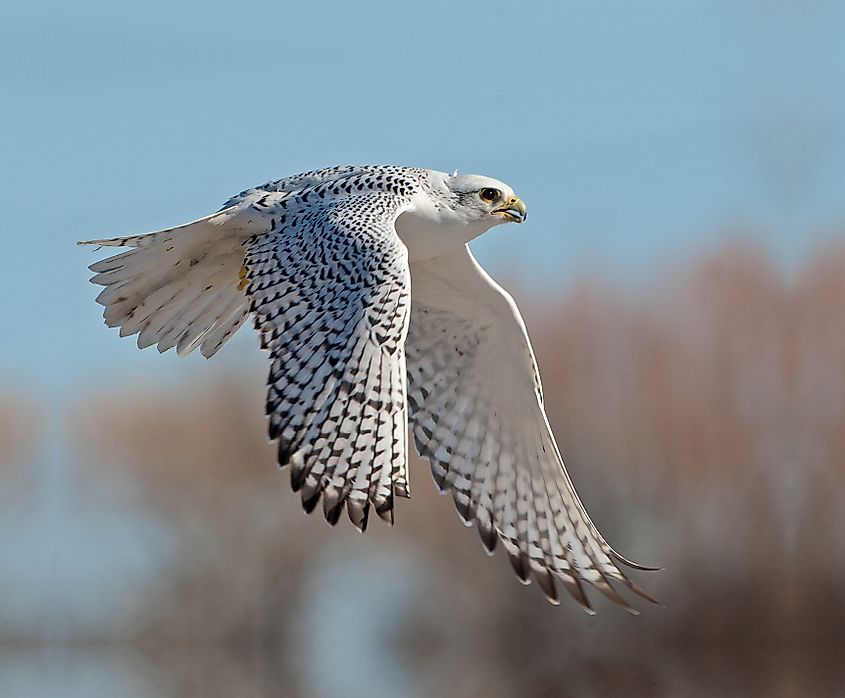
4. Golden Eagle
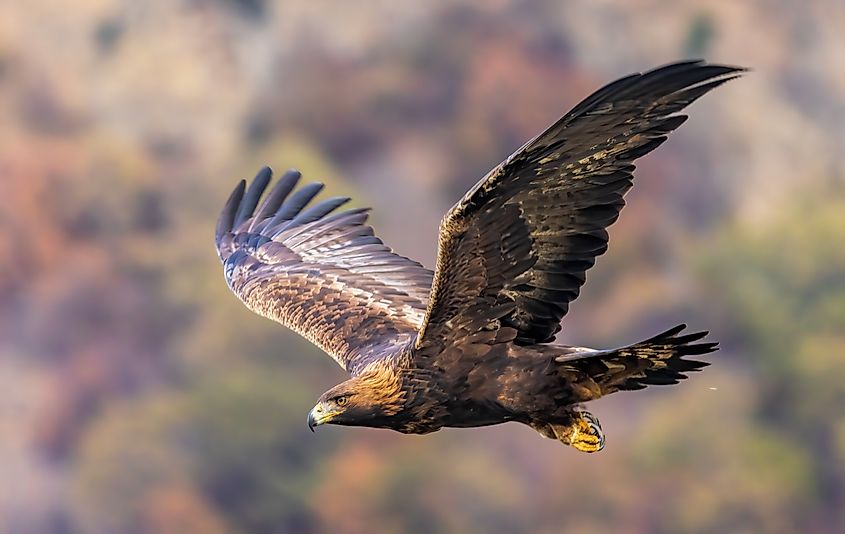
5. Grey-Headed Albatross

The grey-headed albatross (Thalassarche chrysostoma), also known as the gray-headed mollymawk, ranks as the fifth fastest bird by maximum horizontal speed, capable of sustained flight speeds exceeding 127 km/h (79 mph). This large seabird inhabits isolated islands throughout the Southern Ocean, nesting predominantly on South Georgia Island and smaller colonies elsewhere. With an average wingspan of 2.2 meters (7.2 ft) and weight ranging from 2.8 to 4.4 kg (6.2 to 9.7 lbs), it is distinguished by its dark ash-grey head, black upper wings, and white underparts. It has a distinctive black bill with yellow ridges shading to pink-orange at the tip. Exceptionally pelagic, grey-headed albatrosses forage extensively at sea, primarily preying on squid, fish, and crustaceans. Unlike other albatrosses, they feed mostly away from continental shelves.
6. Common Swift
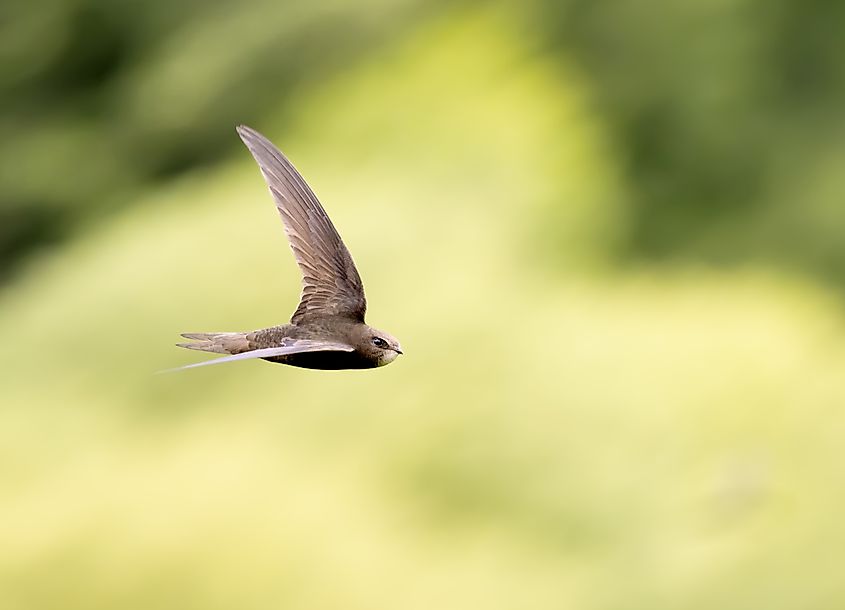
7. Peregrine Falcon
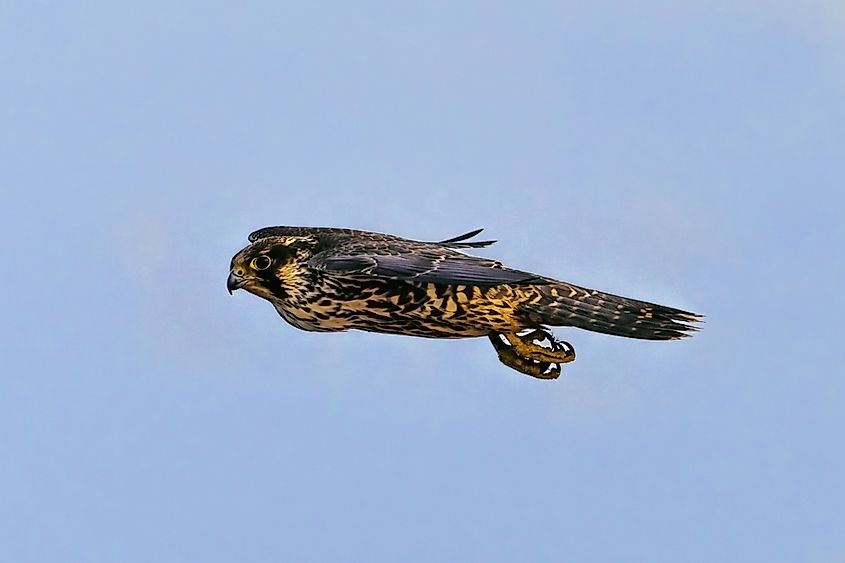
8. Anna's Hummingbird
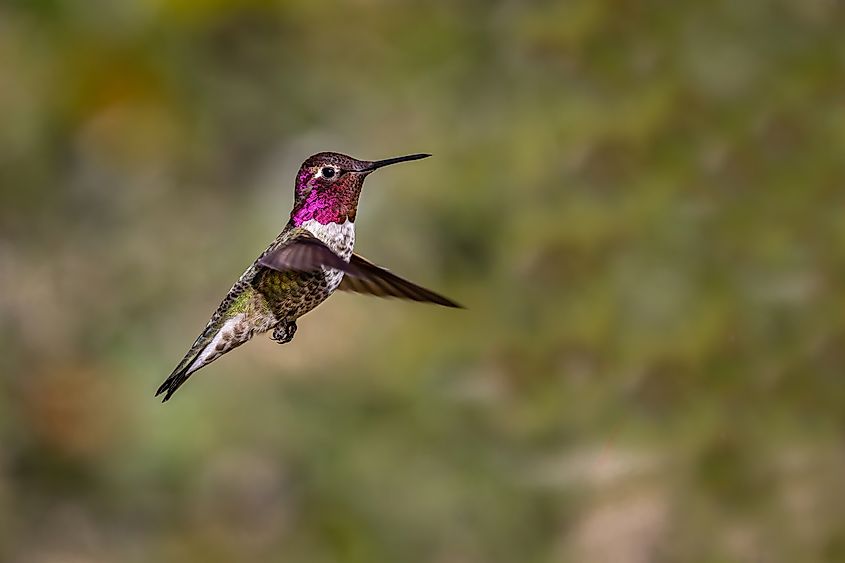
Anna's hummingbird (Calypte anna) ranks among the fastest birds by maximum horizontal speed, capable of sustained flight speeds up to 96.5 km/h (60 mph). Native to western coastal regions of North America, this small bird measures just 9.9-10.9 cm (3.9-4.3 inches) in length, weighs between 2.8 and 5.7 grams, and has a wingspan of about 12 cm (4.7 inches). Males display an iridescent crimson-red crown and throat patch (gorget), uniquely vivid and angle-dependent due to specialized feather structures. Females exhibit duller plumage with smaller gorgets. Originally migratory, Anna's hummingbirds now often remain year-round in northern areas, aided by urban gardens and human-provided nectar feeders. Their diet includes flower nectar, captured via an extendable tongue, and small flying insects. The species demonstrates remarkable aerial agility and adaptability, thriving in human-altered environments and displaying high-speed maneuvers as part of courtship displays and territorial defense.











